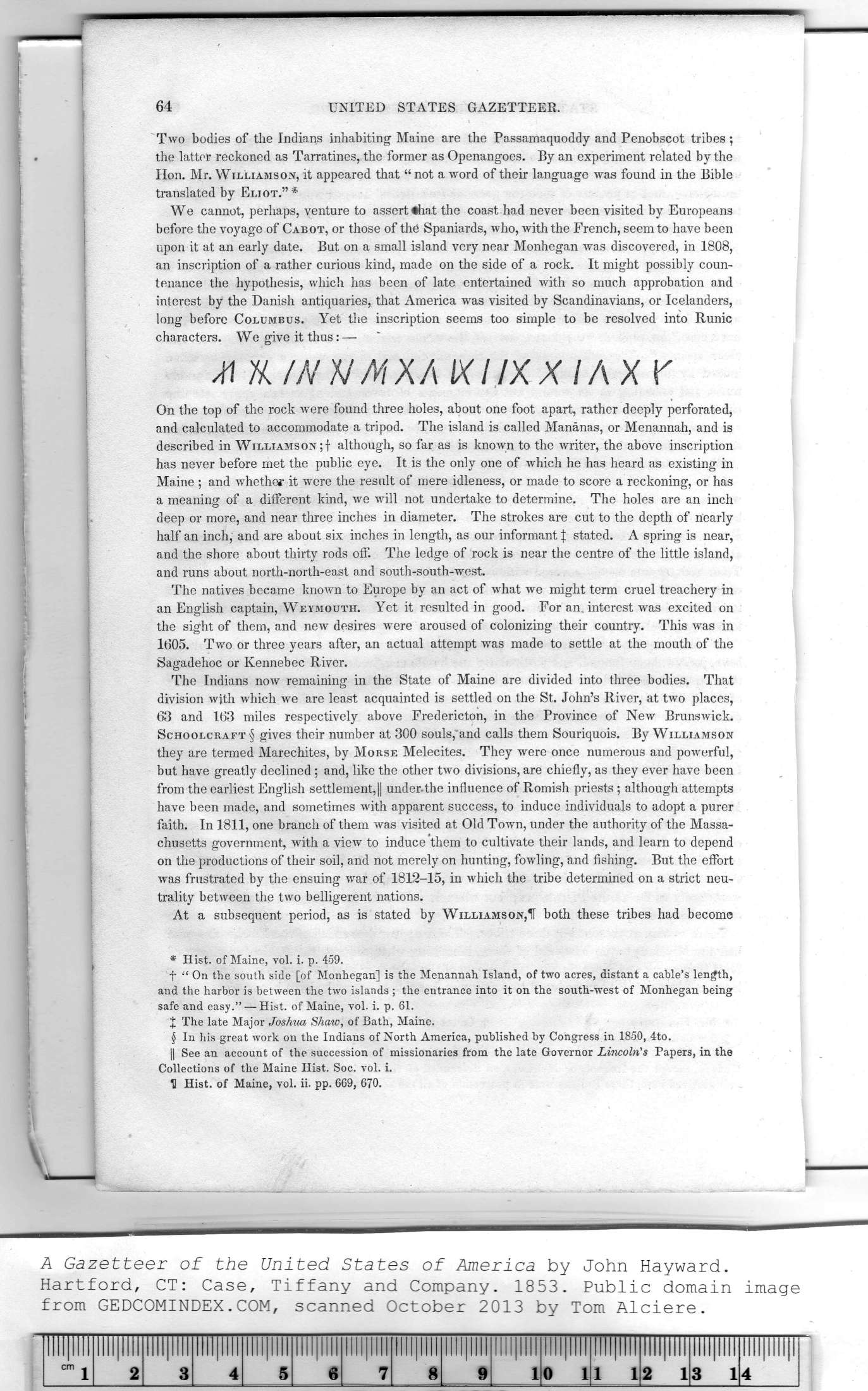|
|
Note: Ctrl and + increases the font size of the text below, Ctrl and - decreases it, and Ctrl and 0 resets it to default size.
64 UNITED STATES GAZETTEER.
Two bodies of the Indians inhabiting Maine are the Passamaquoddy and Penobscot tribes ;
the latter reckoned as Tarratines, the former as Openangoes. By an experiment related by the
Hon. Mr. Williamson, it appeared that “not a word of their language was found in the Bible
translated by Eliot." 1
We cannot, perhaps, venture to assert #hat the coast had never been visited by Europeans
before the voyage of Cabot, or those of the Spaniards, who, with the French, seem to have been
upon it at an early date. But on a small island very near Monhegan was discovered, in 1808,
an inscription of a rather curious kind, made on the side of a rock. It might possibly coun-
tenance the hypothesis, which has been of late entertained with so much approbation and
interest by the Danish antiquaries, that America w'as visited by Scandinavians, or Icelanders,
long before Columbus. Yet the inscription seems too simple to be resolved into Runic
characters. We give it thus: —
MK/NNMXA IXIIX X I AX Y
On the top of the rock were found three holes, about one foot apart, rather deeply perforated,
and calculated to accommodate a tripod. The island is called Mananas, or Menannah, and is
described in Williamson;! although, so far as is known to the writer, the above inscription
has never before met the public eye. It is the only one of which he has heard as existing in
Maine ; and whether it wrere the result of mere idleness, or made to score a reckoning, or has
a meaning of a different kind, we will not undertake to determine. The holes are an inch
deep or more, and near three inches in diameter. The strokes are cut to the depth of nearly
half an inch, and are about six inches in length, as our informant % stated. A spring is near,
and the shore about thirty rods off. The ledge of rock is near the centre of the little island,
and runs about north-north-east and south-south-west.
The natives became known to Europe by an act of what we might term cruel treachery in
an English captain, Weymouth. Yet it resulted in good. For an interest was excited on
the sight of them, and new desires were aroused of colonizing their country. This was in
1605. Two or three years after, an actual attempt was made to settle at the mouth of the
Sagadehoc or Kennebec River.
The Indians now remaining in the State of Maine are divided into three bodies. That
division with which we are least acquainted is settled on the St. John's River, at two places,
63 and 163 miles respectively above Fredericton, in the Province of New Brunswick.
Schoolcraft § gives their number at 300 souls, and calls them Souriquois. By Williamson
they are termed Marechites, by Morse Melecites. They were once numerous and powerful,
but have greatly declined ; and, like the other two divisions, are chiefly, as they ever have been
from the earliest English settlement,|] under-the influence of Romish priests ; although attempts
have been made, and sometimes with apparent success, to induce individuals to adopt a purer
faith. In 1811, one branch of them was visited at Old Town, under the authority of the Massa-
chusetts government, with a view to induce them to cultivate their lands, and learn to depend
on the productions of their soil, and not merely on hunting, fowling, and fishing. But the effort
was frustrated by the ensuing war of 1812-15, in which the tribe determined on a strict neu-
trality between the two belligerent nations.
At a subsequent period, as is stated by Williamson,IT both these tribes had become
A Gazetteer of the United States of America by John Hayward.
Hartford, CT: Case, Tiffany and Company. 1853. Public domain
1
Hist, of Maine, vol. i. p. 459.
|
